A short guide to the Chapel
Welcome to Trinity College Chapel
This Chapel is a place of worship. Please keep noise to a minimum and be respectful if anyone is praying. Food and drink are not permitted, and mobile phones may not be used in the building. Thank you.
You enter the building through the Victorian porch. The text over the entrance reads: 'Dominus custodiet introitum tuum et exitum tuum ex hoc nunc et usque in saeculum' (Psalm 121: 8) - May the Lord keep watch over your coming in and your going out, from henceforth now and for ever. The date 1872 is also carved over the west door.
Once inside, you are standing in the Ante-Chapel. You will immediately notice the six imposing statues, fine sculptures of great Trinity men. Just to your left is the famous statue of Sir Isaac Newton, by the 18th-century French sculptor Roubiliac, who also carved the bust of Daniel Lock, on the wall facing you. Newton is probably Trinity’s most famous alumnus, and one of the greatest scientists of all time; he is depicted holding a prism to represent his theories of light, colour and optics.
 |
 |
 |
 |
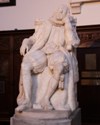 |
 |
| Sir Isaac Newton, one of the greatest scientists of all time. Sculptor: Louis-François Roubiliac, 1755 |
Lord Macaulay, historian and essayist. Sculptor: Thomas Woolner, 1868 |
Alfred, Lord Tennyson, poet. Sculptor: Sir Hamo Thornycroft, 1909 |
William Whewell, Master and benefactor of Trinity. Sculptor: Thomas Woolner, 1872 | Sir Francis Bacon, philosopher and essayist, Lord Chancellor of England. Sculptor: Henry Weekes, 1845 |
Isaac Barrow, Master of Trinity, mathematician and preacher, Newton’s tutor. Sculptor: Matthew Noble, 1858 |
Opposite the statue of Newton is the organ screen, housing the magnificent organ built by Metzler of Zürich in 1976. This mechanical-action instrument incorporates seven ranks of pipework from the organs built by ‘Father’ Bernard Smith in 1694 and 1708, and the original cases have been restored. It is regarded as one of the finest organs in the United Kingdom. Recitals are given before Evensong every Sunday afternoon during Term, and at other times.
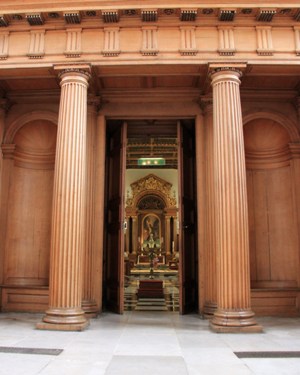 Walk through the oak doors under the organ screen and enter the Chapel proper. This is where religious services have taken place regularly since the foundation of Trinity in the mid-sixteenth century. A morning service is said every day during term-time, and the College Choir of thirty undergraduates sings candlelit services three or four times a week. As befits the College founded by Henry VIII, the Chapel is part of the Church of England, though its status differs slightly from that of parish churches. Members of the public are welcome to attend all services. Special College ceremonies are also held in the Chapel, including the installation of new Masters, and the admission of new Scholars and Fellows each year.
Walk through the oak doors under the organ screen and enter the Chapel proper. This is where religious services have taken place regularly since the foundation of Trinity in the mid-sixteenth century. A morning service is said every day during term-time, and the College Choir of thirty undergraduates sings candlelit services three or four times a week. As befits the College founded by Henry VIII, the Chapel is part of the Church of England, though its status differs slightly from that of parish churches. Members of the public are welcome to attend all services. Special College ceremonies are also held in the Chapel, including the installation of new Masters, and the admission of new Scholars and Fellows each year.
The building, which is 205 feet (62.5m) long, was begun in 1554-55 by Queen Mary, the daughter of Henry VIII by his first wife, Catherine of Aragon. Mary, a Roman Catholic, was succeeded by her Protestant half-sister Elizabeth I, Anne Boleyn’s daughter, who completed the Chapel in 1567.
The architectural style is Tudor-Gothic, with Perpendicular tracery and pinnacles. The roof is of an earlier style than the rest of the building, and may have been re-used from the chapel of King’s Hall which preceded Trinity College on this site. Only the walls and roof are of Tudor date.
The first thing you see as you enter is the brass eagle lectern, designed in typical Victorian style. It was a gift to the College by the Master, W.H. Thompson, in 1866.
The arrangement of the wooden stalls (bench seats) along the sides of the Chapel is typical of Cambridge and Oxford colleges. The stalls, panelling, organ screen and reredos date from the early eighteenth century. The coats of arms above the stalls are worth a close look: the carving is in the style of Grinling Gibbons, though the sculptor was not Gibbons but John Woodward. They date from 1755-56, and commemorate Fellows of Trinity, including Newton, who subscribed to a fund for refurbishing the Chapel.
The choir stalls are in the centre of the building, and project further out into the aisle than the other stalls. The Choir of about thirty undergraduates sings Choral Evensong three times a week during Term-time, and many special services throughout the year; they also give occasional concerts in Chapel, as well as many external concerts, tours and recordings. Here in Chapel the singers wear black cassocks and white surplices for ordinary services, and for feast days scarlet cassocks, which may only be worn by members of royal foundations.
The stone and marble raised pavement at the east end of the Chapel was built in 1636, along with the altar. On the pavement, in front of the high altar, an inscription reads: ‘In memory of the men of this College who gave their lives in war MCMXIV – MCMXVIII’. On the wooden panelling on either side of the altar are inscribed the names of over six hundred men, students, staff and Fellows of Trinity, who gave their lives in the First World War. The inscription around the top of the panelling translates as: All these people were still living by faith when they died. They did not receive the things promised; they only saw them and welcomed them from a distance, admitting that they were foreigners and strangers on earth (Hebrews 11: 13).
It is impossible to ignore the huge oil painting of St Michael binding Satan, painted in 1768 by the Anglo-American artist Benjamin West. It was a gift to the College from the then Master, Dr John Hinchliffe. The elaborate gilded wooden reredos holding the painting is known as the baldacchino; it was built in the early eighteenth century in the Neo-Classical style.
The great east window above the altar has been bricked up since 1706. The stained glass in the Chapel windows is mid-Victorian (1871-5). The themes were devised by B.F. Westcott and F.J.A. Hort, both distinguished Trinity theologians, and portray an eclectic choice of characters from the Bible, figures from English and continental history, and people with connections to Trinity. You might be able to spot Henry VIII with his authoritative stance, and Queen Mary holding a miniature Trinity Chapel (window 6 on the north side). The work was executed by the Pre-Raphaelite artist Henry Holiday. Many of the faces of the great historical figures of the Church are actually portraits of eminent Victorians.
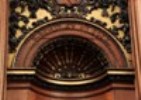 |
As you walk back down the Chapel, notice the elaborately decorated stalls on either side of the main door. These are the special seats for the Master and the Vice-Master. They were commissioned in the eighteenth century by Trinity’s most famous (and controversial) Master, Richard Bentley, whose name is inscribed above his stall (on the left) – though he was rarely seen in the Chapel during the forty-two years of his Mastership. The Vice-Master's stall bears the name of Dr Richard Walker. | 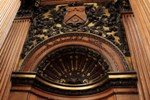 |
As you re-enter the Ante-Chapel, turn to your right and go through the wooden doors into the Vestry. This is where the clergy prepare for services: their robes or 'vestments' are stored in the large chest. A door leads to the Choir Vestry, where the Choir learns the music and robes for services. The Vestry altar is used for small-scale services and private prayers.
Also in the Vestry you will find one of Trinity’s little-known treasures: the Sekford tomb. Like so many statues in English churches, this monument was defaced on Oliver Cromwell’s orders in the mid-seventeenth century, probably by William Dowsing in 1643, but it is still a touching memorial to a young student who died at the age of 15. He is dressed in red, denoting his status as an undergraduate; the fact that he was buried here and not at his family home suggests that he must have loved Trinity. The monument is a rare example of a canopied tomb chest.
Return to the Ante-Chapel, where you will notice the numerous brass plaques on the wooden wall panelling. Nowadays only members of the Foundation who are of “exceptional intellectual eminence” or have given “exceptional service” are honoured with memorial brasses. Among the most notable men commemorated here are the composer Ralph Vaughan Williams, the philosopher Ludwig Wittgenstein, the physicist Ernest Rutherford, the poet A.E. Housman and the anthropologist J.G. Frazer.
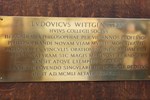 |
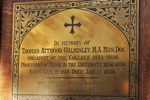 |
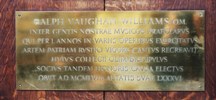 |
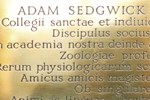 |
| Wittgenstein | Walmisley | Vaughan Williams | Sedgwick |
Between 1567 and 1886 many deceased members of Trinity were interred beneath the Chapel floor, the earliest being John Beaumont, brother of Trinity’s fifth Master, Robert Beaumont. Just one woman, commemorated as Elizmar Smith, is interred in the Ante-Chapel. Her name was actually Elzimar; she was the sister of the then Master, Robert Smith, and was buried under a stone which might originally have been intended for her brother: it bears the arms of their cousin, Roger Cotes, who is buried nearby. Robert Smith is buried near the altar in the main Chapel.
Finally, look behind Newton’s statue at the Second World War memorial on the west wall of the Ante-Chapel. It was carved from Portland stone, by David Kindersley's workshop, in 1951. 384 members of Trinity are commemorated, with an inscription which translates as: Night and day they were a wall around us (1 Samuel 25: 16).
As you leave the Ante-Chapel you might like to make a donation in the wall-box in the porch. No charge is made for your visit, and all donations are given to charity.
Download our short guide or our longer guide to the Chapel by clicking the links.
We hope you enjoy your visit to Trinity College Chapel.
